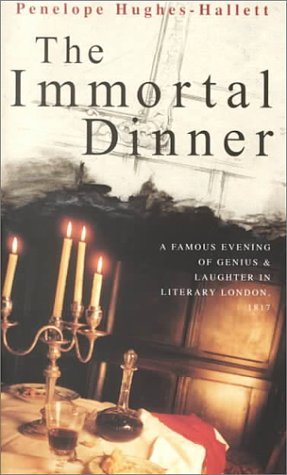The nineteenth-century painter Benjamin Robert Haydon was convinced that his best works rivalled the masterpieces of the Renaissance—a judgement facilitated by his near-blindness. Standing in front of one of them, his noble, ugly face masked by several pairs of spectacles, he exclaimed: “What fire, what magic! I bow and am grateful.” Wordsworth, who also suffered from poor eyesight, called Haydon “the first painter in his grand style of art that England or any other country has produced since the days of Titian”.
When he was not painting, Haydon found time for literature and socialising, two interests that he combined on 28 December 1817, when he threw a dinner party at his house at 22 Lisson Grove, Paddington, to which he invited the poets Keats and Wordsworth. Also among the company were the essayist and wit Charles Lamb and the young physician Joseph Ritchie, who was preparing to lead his ill-fated expedition to Africa in search of the source of the Niger. Above them hung Haydon’s unfinished magnum opus, Christ’s Entry into Jerusalem. That evening provides the focus for Penelope Hughes-Hallett’s elegantly written book, which promised in conception a kind of Joycean time trick: the elaboration of a few hours of real time over three hundred pages. It could have been the ultimate compliment paid to a dinner-party host.
But, perhaps inevitably, that isn’t what we get. Even Haydon’s wonderful, gushing diary does not provide enough fodder, and Hughes-Hallett has sadly to be speculative about many of the more interesting details. Thus we are told, “All Haydon’s guests would have walked to his party”, “Wordsworth no doubt wore his brown overcoat”, and “The main fish dish would probably have been salmon.” In other words, we do not know. We do not know what they ate, who arrived first, who left last. We do not have the minutes of their conversation. We can’t be certain what they were wearing, who sat next to whom, or whether Keats got drunk. Haydon says they had “a glorious set-to—on Homer, Shakespeare, Milton and Virgil”. We don’t know what was said.
Consequently, the book becomes in part a short biography of Haydon, interwoven with the potted lives of his friends. And in part it is a marvellous exercise in digression, which succeeds in giving a flavour of life in 1817—the year the Habeas Corpus was suspended, Coleridge published Biographia Literaria and the Duke of Wellington bought Apsley House—that could not easily be got from a conventional biography or work of history. After the eruption of Mount Tamboro in the East Indies in 1815, Hughes-Hallett tells us, “The resulting haze of stratospheric dust caused unusual optical effects, which may have been one reason for the characteristic cloud formations in Constable’s and Turner’s skies, and particularly for the colours in Turner’s sunsets.” In front of large audiences, top-hatted surgeons sliced into unanaesthetised, screaming patients. Regency bucks referred to having a child as “knocking out an apple”, and used the expression to “hang out” much as it is used today. “Where do you hang out?” meant “What club or restaurant do you go to?”
In other words, what Haydon characteristically chose to refer to as “the immortal dinner” turns out to be a hook on which to hang a picture of the character of the times. And in this respect the book runs the risk of resembling one of Haydon’s grandiose paintings: full of bold touches and strokes of colour (the 5ft-tall Keats leant slightly backwards to make himself seem taller), of purpose and of incident (Wordsworth was in a good mood that evening because he had scored off his friend Coleridge the night before), but not, ultimately, achieving an accumulative force. If it avoids this fate, it is thanks to the intensely human character of Haydon himself, whose life provides a thread to hold the book together. It is hard not to like the man of whom Hazlitt said, “He sets one upon one’s legs better than a glass of champagne”, and whose favourite pleasure was to watch his wife waking up in the morning. But he was not made for the more practical side of life. Part of the trouble was that, although it was to experience a resurgence of popularity in the wake of the Pre-Raphaelite movement in the second half of the nineteenth century, the kind of big-canvas, moral historical paintings that Haydon laboured at was not where the future of painting lay.
In addition to this, he was hopeless with money, and too quick to take offence and alienate rich patrons who could have provided help when times were hard. Haydon found himself in the debtors’ prison again and again. Artistic triumphs became fewer as he grew older. Keats was dead. Lamb and Ritchie were dead. Finally, at the age of sixty, he bought a gun and shot himself in his painting room. This failed to kill him, and he had to crawl across the floor to his razor, with which he slit his throat and finished off the job. His self-penned epitaph was too long to be carved on his tombstone. Here at last, in Penelope Hughes-Hallett’s unusual, sparkling portrait of Regency life, Benjamin Robert Haydon receives his due.

